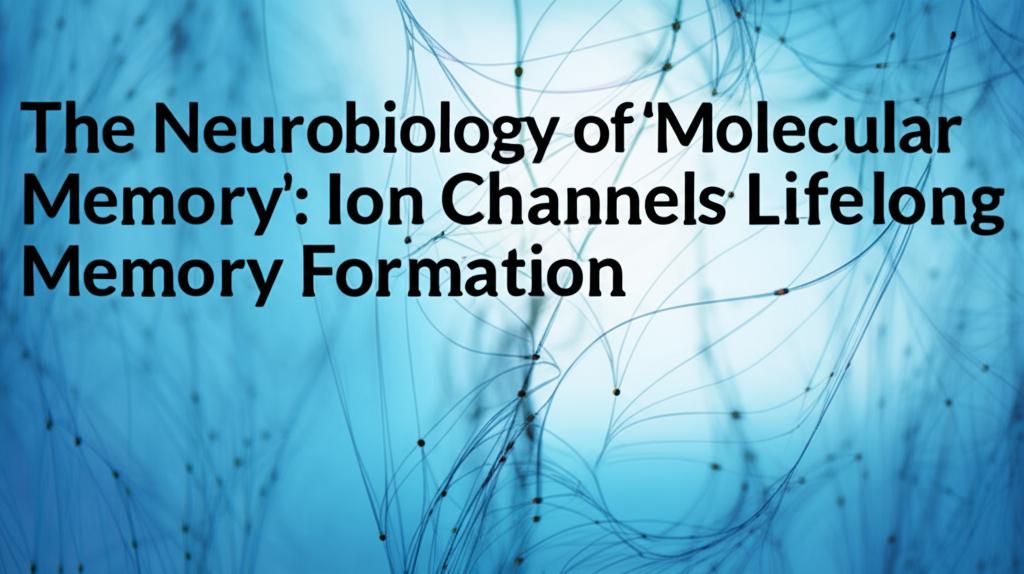The brain's remarkable ability to form and retain memories throughout a lifetime relies on intricate processes at the molecular level, with ion channels playing a pivotal role. These channels, essentially pores in the membranes of neurons, control the flow of ions, thereby regulating neuronal excitability and communication. Recent discoveries are shedding more light on how these tiny molecular machines contribute to the enduring nature of memory.
At the heart of memory formation is synaptic plasticity, the capacity of synapses (the connections between neurons) to strengthen or weaken over time in response to changes in neural activity. This reshaping of neural circuits is fundamental to learning and memory. Ion channels are critical players in synaptic plasticity.
One key type of ion channel extensively studied for its role in memory is the calcium ion channel. Specifically, the CaV2.1 calcium channel, prevalent in the brain, has been shown to possess a form of 'molecular memory'. When a neuron is repeatedly stimulated by electrical signals, these channels can change their shape and become less likely to open. This 'declutched memory state' can persist for several seconds in individual channels. While seemingly brief, this effect can accumulate across numerous channels and neurons. This accumulation can lead to a reduction in communication between specific neurons, contributing to changes in the receiving neuron that can last for hours or even days. Ultimately, these short-term molecular memories can contribute to much longer-lived changes in the brain, such as the elimination of weakened synapses, thereby playing a part in the consolidation of lifelong memories. Researchers have found that these channels can adopt almost 200 different shapes depending on the strength and duration of electrical signals, highlighting their complexity.
Other crucial ion channels involved in memory include NMDA (N-methyl-D-aspartate) receptors and AMPA (α-amino-3-hydroxy-5-methyl-4-isoxazolepropionic acid) receptors. Both are activated by the neurotransmitter glutamate. NMDA receptors are considered "coincidence detectors". They require both glutamate binding and sufficient depolarization of the neuron to open and allow calcium ions to flow in. This calcium influx is a critical trigger for downstream signaling pathways that lead to long-term potentiation (LTP), a persistent strengthening of synapses, and long-term depression (LTD), a weakening of synapses, both vital for memory formation. AMPA receptors, also permeable to ions like sodium and sometimes calcium, are involved in the expression of LTP. The number and activity of AMPA receptors at the synapse can be dynamically regulated, influencing synaptic strength. The interplay between NMDA and AMPA receptors is crucial for initiating and maintaining the synaptic changes underlying memory.
Furthermore, potassium channels, the most diverse group of ion channels, also contribute significantly to shaping neuronal responses and synaptic plasticity. Certain potassium channels, activated by intracellular calcium, can modulate neuronal excitability and influence the duration and strength of synaptic signals.
Recent research has also begun to explore how different ion channels, like NMDA receptors and BK (large conductance calcium-activated potassium) channels, can form complexes, or "channelosomes". These macromolecular complexes allow for precise regulation of neuronal function and synaptic plasticity by coordinating the activity of multiple channels. Dysregulation of these ion channels and their interactions is increasingly implicated in various neurological and neurodevelopmental disorders that affect learning and memory.
The ongoing exploration into the molecular intricacies of ion channels continues to reveal their sophisticated roles in transforming transient experiences into lasting memories. This deeper understanding not only illuminates the fundamental processes of cognition but also opens avenues for potential therapeutic interventions for memory-related disorders by targeting specific aspects of ion channel function.

